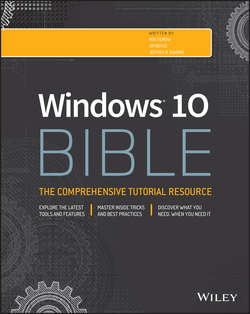Читать книгу Windows 10 Bible - Shapiro Jeffrey R. - Страница 37
На сайте Литреса книга снята с продажи.
Part I
Getting Started
Chapter 4
Sharing and Securing with User Accounts
Creating and Managing User Accounts
ОглавлениеThe best way to handle user accounts in a home setting is for one person to play the role of administrator, even if that person isn't a professional. In a home environment, that person most likely is a parent who needs to define parental controls. To begin, log in to a user account that already has administrative privileges. If you have only one user account, or you're taken straight to the desktop at startup, that account probably has administrative privileges.
As with most configuration tasks, you can create and manage user accounts through the Computer Management application, which you can access by right-clicking the Start button. Or you can create local accounts from the Accounts applet we just used to create a Microsoft account.
If you're in a standard account on a computer that already has a password-protected administrative account, you must enter the password for the Administrator account. Or, if the administrative account doesn't have a password, press Enter to leave the password box empty.
Changing user accounts
When you create a user account, you give it a name and choosing a type. After you've created a user account, you can change the name and type to better suit your needs. Use the Setting, Accounts page shown in Figure 4.8 or the Accounts screen shown in Figure 4.10 to make changes to accounts.
CAUTION
If you aren't careful when you delete a user account, you can delete all the files in that account. Read the section “Deleting User Accounts” later in this chapter before you delete an account. If you make a mistake, you can delete photos or other documents that may be difficult or impossible to recover.
Changing a user account type
You can change an Administrator account to a standard account, or vice versa, from the main Accounts page. For example, if you've been using an administrative account for your day-to-day computing since buying your computer, you may want to change it to a standard account for the added security that a standard account provides. At least one user account must have administrative privileges, so you can make this change only if at least one other user account on the system has administrative privileges.
To change an account's type, click the account's icon or name on the Accounts page. Then click the Change an Account link at the bottom right of the accounts page as That page lets you change the account in a number of ways when you click Change, or simply remove the account.
Password-protecting an account
You have the option to set up local accounts without password protection (Microsoft accounts require passwords). If you share your computer with other people, chances are, you want to keep some people out of the Administrator account. Likewise, you want to keep some users from having administrative privileges. This is especially important with parental controls. If the administrative account isn't password-protected, the kids won't take long to figure out how to bypass your controls.
CAUTION
Don't forget the password you set on the administrator account if it's the only administrator account; otherwise, nobody has administrative privileges, and that causes a world of headaches. So, think up a good password and password hint, and make sure you enter the password correctly when you set it.
To password-protect a user account, go to the main page for the user account. For example, if you're on the Accounts page, click the user account you want to password-protect and then click Sign-in Options. You're taken to the page that lets you change the password. If you've been using the account for a while without a password, heed the warnings. If it's a brand-new account, you have nothing to worry about.
To password-protect the account, type your password in the New Password text box. Then press Tab or click the Confirm New Password text box and type the same password again. You don't see the characters you type – only a placeholder for each character.
TIP
When you type passwords, the characters are always hidden to prevent shoulder surfing. Shoulder surfing is a simple technique for discovering someone's password by watching over the person's shoulder as he or she types it.
Next, enter a password hint in the Type a Password Hint text box. The hint should be something that reminds you of the forgotten password, but not a dead giveaway to someone trying to break into the account. Click Create Password after you've filled in all the blanks.
If you see a message indicating that your passwords don't match, retype both passwords. Make sure you type the password exactly the same in both boxes. Then click the Create Password button. You're taken back to the main page for the user account when you've successfully entered the password in both boxes and provided a password hint.
You can repeat the process to password-protect as many accounts as you wish. If you're creating user accounts for people other than yourself, set a default password for the account and let the other users manage their own passwords. In our opinion, every account should have a password.
Конец ознакомительного фрагмента. Купить книгу
